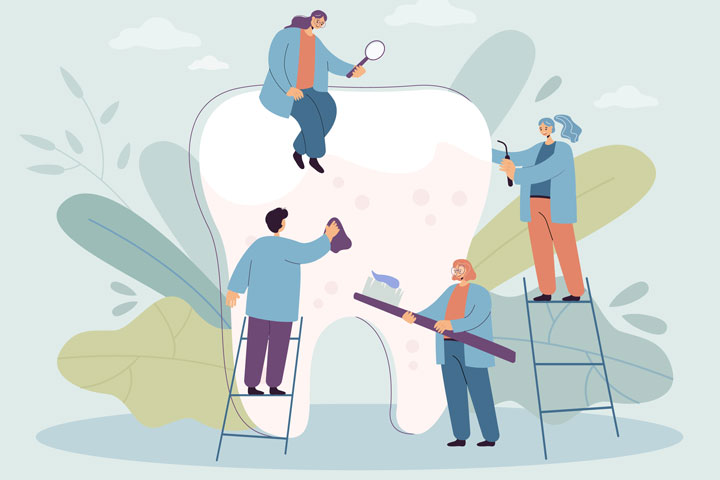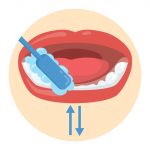
Brushing Techniques
It is not a widely known fact that brushing your teeth correctly using the correct texture of toothbrush is more important than the brand of toothpaste you use. Though many brushing techniques are available, this section will display the one that is relatively easy an defective for most individuals.
4 MINUTES A DAY TO BRUSH PLAQUE AWAY
Brushing every day is a fundamental component to effective oral hygiene helping keep teeth and gums from bacterial biofilm (plaque). Plaque (bacteria) is constantly forming on your teeth. Therefore, it is recommended that you brush 2 minutes in the morning and 2 minutes in the evening, no less, in order to efficiently remove this “sticky film”. While growing up, children are often told to brush after eating their favorite sugary or starchy food or beverage. The reason has to do with the interaction between these foods and the bacteria in the mouth. In the presence of sugars or starches, the bacteria produce an acid that attacks the tooth enamel. The stickiness of the plaque keeps the acid in contact with your teeth. Without the removal of the plaque, dental caries (cavities) will progressively appear.
Plaque needs to be removed through a daily oral care routine which includes brushing and flossing or the plaque will harden into tartar (or calculus). When it hardens, the tartar will need to be removed by your dental professional.
Effective oral health starts with the gums. Today, gum disease is one of the most common dental problems. One of the issues with gum disease is that it often develops slowly and without pain. When plaque (tartar) is allowed to accumulate, infection will occur at the point where the gums attach to the teeth (called the “point of attachment”).
Dental Home Care
One must brush and floss regularly after every meal and at a minimum twice a day. The key is not only to do it regularly but also to do it right. Here’s how:
- Place bristles along the gumline at a 45 degree angle. Bristles should contact both the tooth surface and the gumline.
- Gently brush the outer tooth surfaces of 2-3 teeth using a vibrating back, forth & rolling motion. Move brush to the next group of 2-3 teeth and repeat.
- Maintain a 45° angle with bristles contacting the tooth surface and gumline. Gently brush using back, forth & rolling motion along all of the inner tooth surfaces.
- Tilt brush vertically behind the front teeth. Make several up & down strokes using the front half of the brush.
- Place the brush against the biting surface of the teeth & use a gentle back & forth scrubbing motion. Brush the tongue from back to front to remove odor-producing bacteria.
Use a good toothbrush
Your toothbrush should have soft nylon bristles which are gentler on your gums. It is recommended that you should get a new one every 3 months, or as soon as the bristles start to splay out and lose their shape.
Use a reputed branded toothpaste
A fluoridated toothpaste not only helps remove plaque but also helps strengthen tooth enamel. Choose your toothpaste carefully based on your specific needs
Wet your toothbrush
Squeeze only a moderate amount ( approximately a little over half the length of toothbrush head) of toothpaste onto your toothbrush.
Set your bristles at the gum line at a 45-degree angle
Gently brush with a short, vertical or circular motion. Don’t brush across your teeth.
Clean all your teeth
Brushing just a few teeth at a time, work your way around your mouth so that you get every tooth, spending about 12 to 15 seconds in each spot. If it helps, you can divide your mouth into quadrants: top left, top right, bottom left, and bottom right. It is recommended to spend 30 seconds on each quadrant.
Brush the inner surfaces of your teeth
Tip the toothbrush so that the head of the toothbrush is pointing towards your gum line, and brush each tooth. Dentists report that the most commonly skipped area is the inside of the lower front teeth, so be sure not to forget those! Rinse out your mouth with plain water.
Rinse your toothbrush.
At the very least, brush your teeth in the morning and before you go to bed. Brush after every meal if possible, but don’t overdo it: too much brushing is not good for your teeth.
Try to brush your teeth after drinking coffee, red wine, or dark teas. Over time, all these beverages can stain teeth permanently. Visit a Dentist at least once every six months for a routine check-up and cleaning.
Brushing in Children
- Parents of children aged 0-2 are encouraged to brush their child’s teeth as soon as the first tooth appears, using a soft toothbrush and water only.
- It is not recommended to use fluoride toothpaste for children aged 0-2 years.
- From age 2-7 years use a small pea size amount of fluoride toothpaste containing at least 1,000 ppm(parts per million) Fluoride
- Parents of children under the age of 7 should brush their child’s teeth until they are able to do so properly themselves.
- Brush twice a day.
When brushing, it is important to use toothpaste that contains fluoride. Fluoride helps harden the outer layer of the tooth, called enamel, which will prevent cavities and also reduce bacteria in the mouth. It can also reverse the formation of smaller cavities.
Lastly, antibacterial rinses can also help reduce bacteria in the mouth. Please check with your dentist or dental hygienist if you have any additional questions.
Points to remember while brushing
- Use soft toothbrushes of REPUTED companies only. Do not compromise for a few rupees.
- The optimum brushing time is 2 mins.
- Do not use horizontal strokes, this can surely cause wear and tear of tooth enamel commonly known as TOOTHBRUSH ABRASION.
- Change your toothbrush frequently- every 2-3 months is ideal.
- Protect your brush head with a cover or wash your toothbrush thoroughly before brushing.
- For children and for individuals with restricted mouth opening, use a baby or small-headed toothbrush.
Lorem ipsum dolor sit amet, consectetur adipiscing elit. Ut elit tellus, luctus nec ullamcorper mattis, pulvinar dapibus leo.











